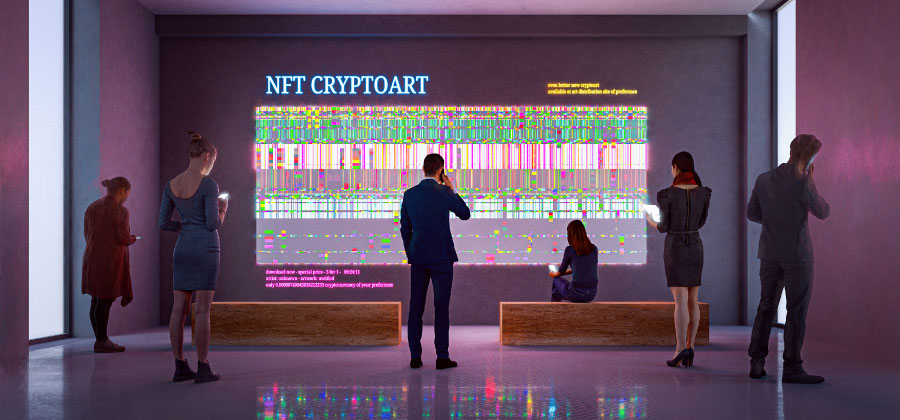NFTs and the Dawn of the Metaverse

Non-fungible tokens (NFTs) are the new crypto gold rush. There’s been an explosion of interest in them, with people paying millions for digital art pieces, and expectations are running hot.
NFTs use the same blockchain technology as cryptocurrencies, but can represent anything―a piece of art, a song, a boat, or real estate, for example. An NFT is not “fungible” (interchangeable) like a bitcoin, which has the same value as any other bitcoin. Instead, NFTs are “non-fungible” (unique), meaning that the value differs regardless of what they represent. NFTs are like digital property deeds that provide a verifiable way to transfer ownership of anything you can imagine—big or small, physical or digital.
One might expect the rise of NFTs to spur rampant speculation, and it has. That will eventually subside, however, and leave behind new markets for products and services. We see this occurring already with NFTs giving a new generation of digital-first artists an effective way to monetize their creative skills.
Use Cases and Advantages of NFTs
Only a fraction of the world’s wealth is held in currencies; much more is held in assets (as well as derivatives). While many of these assets have unique value, that value is often subjective; so, we use a certain amount of fiat currency to exchange value. Given cryptocurrencies are the supposed virtual alternative to global fiat currencies or gold, we can foresee a similar wealth distribution for virtual assets—meaning that while the NFT market is currently much smaller than cryptocurrencies, it has the potential to expand greatly over the next few years to become a significant portion of global wealth.
NFTs can be used for any kind of assets. They can be used to provide fractional ownership of physical assets such as real estate, art, and diamonds, and they’re also being used for purely virtual assets including virtual real-estate and even collectible digital cats. The nature of the virtual world removes limits on the type of assets that can be created and owned, and NFTs provide a transparent and verifiable mechanism to authenticate ownership of those assets.
One of the main advantages of NFTs will be more consistent digital rights management. After ownership of an NFT is transferred, the owner can do whatever they wish with it―such as resell, distribute or license it―within the constraints built into the NFT by the issuer. This is possible due to another aspect of NFTs: smart contracts that allow issuers to ensure their rights are maintained throughout the lifetime of the NFT, even in secondary markets. For example, an issuer might require royalties on future transfers in an NFT’s smart contract.
Drawbacks of NFTs
The nature of blockchain means that all transactions are visible. This transparency is a main advantage of the technology, but some users may not want the details known (though the beneficiaries’ identities would remain private). Privacy-focused cryptocurrencies have addressed this issue in different ways, but smart contracts might make it a bigger problem. The details in the contracts must be integrated with the NFT when it’s issued, so they can be extracted by anyone—providing insights that might otherwise be confidential. A few blockchain projects are trying to address this, but the largest networks—including Ethereum, the most popular network for NFTs—do not.
Another issue: transactions associated with an NFT are recorded on the blockchain, but the asset exists elsewhere. Most virtual assets are held in systems that are not as robust or transparent as blockchain—instead, they are often stored on separate servers as normal files that can be corrupted or lost. There is technology that addresses this issue, but it is not standardized. (Note: This issue does not apply to tokenized physical assets).
Additionally, as we saw in the early ICO boom, there have been dishonest practices associated with NFTs. Some artists are trading NFTs with each other to inflate prices. Others are uploading art they don’t own and “claiming” it. These are predictable problems, but they’re exacerbated by the fast pace of adoption in this new market.

NFTs and In-Game Virtual Assets
Since the start of the pandemic, people have adopted largely digital, online lives. Video games have been major beneficiaries of this shift, particularly online multiplayer games where people can gather not only to play together, but to socialize, watch concerts, and more.
These kinds of games, many of which are free to play, make money by enabling players to purchase extra in-game virtual assets such as items or “skins” (costumes for their characters) through online micro-transactions. Many in-game purchases are temporary or are sold through challenges to create scarcity and increase their perceived value. As a result, illegitimate secondary markets for these assets have emerged.
The increase in online gaming has driven a similar increase in the volume and aggregated value of these virtual assets: for example, one online game’s GDP is $500MM, and another has sold digital spaceships for $2,500―or double that amount on secondary markets. Though the total value of assets in each video game is relatively small, these are isolated universes with millions of active users and thus significant growth potential.
Crucially, however, few of the in-game assets sold today are NFTs—meaning that, for the most part, the players that buy them don’t legally own them. NFTs therefore seem to be a natural fit for these assets, but the gaming industry has only recently begun to investigate them. A successful example is a virtual soccer trading-card game that recently raised $50MM in a Series A round. There are also a few companies focused on developing the gaming NFT space.
A potential catalyst for major video game publishers to adopt NFTs might be the regulations currently being created for cryptocurrencies. When the idea of ownership of specific virtual assets becomes standardized, these regulations could be applied to the broader space of virtual assets, including in-game assets. That could force the standardization of NFTs to consolidate their legal status―and sprout a new wave of opportunities.
NFTs Are the Building Blocks of the Metaverse
NFT-based markets for physical real estate, digital art, and Fortnite skins might seem only slightly interconnected, but they are all part of a larger opportunity: the Metaverse. As conceptualized in books and movies beginning in the 1990s, the Metaverse is the virtual alternative to our physical universe and may be the next version of the internet.
It isn’t yet clear if the Metaverse will be one consolidated entity (like the internet) or many separate interwoven ones (like social media companies), but the way it develops will determine its impact on the financial industry. If there are multiple entities, for example, each will have its own rules and may not follow existing risk models.
To envision the potential scale of NFT assets in the Metaverse, imagine a virtual world where every conceivable asset can be bought, sold or traded. Like that world, the Metaverse wouldn’t be constrained by real-world limitations such as raw resource limits, supply chain risk or physics.
Why does this matter to financial institutions?
Safeguarding assets is one of the core activities of many financial institutions, and as new asset types emerge, they must quickly learn to master and manage them in the best interests of their clients. NFTs are simply the next new asset type.
Chirdeep Singh, Markets Entrepreneur-in-Residence, D10X, Citi Ventures; Saskia Pump, Strategic Partnerships, D10X, Citi Ventures; and Greg Girasole, Senior Vice President, Citi Investment Management contributed to this article.
For more on DLT, digital assets, and the metaverse, click here.
